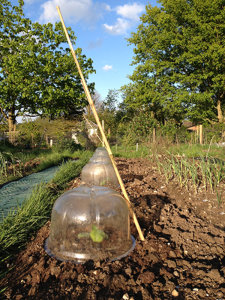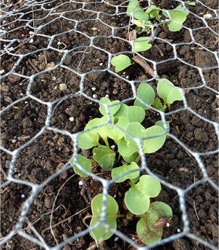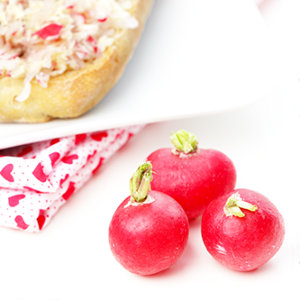Pak Choi is grown for its tasty leaves which are superb when added to stir fries and salads.
The taste is similar to that of mild cabbage and spinach and is a popular addition to many oriental dishes.
 Despite the cold snap we've had this week (I had to give in and put the heating back on although I refuse to get my furry winter boots back out!) there's been a lot going on in the vegetable plot.
Despite the cold snap we've had this week (I had to give in and put the heating back on although I refuse to get my furry winter boots back out!) there's been a lot going on in the vegetable plot.
The carrots (Flyaway variety) that I sowed three weeks ago have finally germinated. I feared they wouldn't make it as it turned very cold and wet just after sowing, but I now have three rows of carrots and I thinned them out today (no matter how carefully I think I spaced them, invariably I end up with a bunch somewhere).
I also sowed some rows of perpetual spinach, some pak choi (mei-qing variety). As I don’t want everything ready at the same time I just do 4 or 5 plants at a time, and then in a couple of weeks I’ll do the same again. This successional sowing should produce a steady supply to harvest rather than a glut all at once.
Today I also sowed what seems like a ridiculous amount of sweet corn (84) but we love it and no matter how many I plant it's never enough. I sowed them (Honey Bun variety) directly outside, in blocks rather than rows because they're wind pollinated and so they need the chance to pollinate each other. It is much harder for the wind to do that if they're planted in a single row. I help the pollination out myself later in the year with the aid of an old envelope, I’ll show you how in a later blog.
I've sown lots of borlotti beans in fibre pots and they’re all in the cold frame. After they've germinated I'll plant them out when it's warmer (assuming it does get warmer!) I also have some small bell pepper plants in the cold frame; it's getting crowded in there!
The pumpkin and squash seeds that had been camped out on my windowsills indoors and then graduated to the cold frame, were today planted out in their final spots. I dug a large hole for each, filled with well-rotted manure and planted each one into the manure filled hole.
 Squash and pumpkins are exceptionally greedy, so they'll appreciate this start to the growing season. I've also covered them with plastic bell cloches for a few days, just to ease them into the transition from the cold frame to the wild.
Squash and pumpkins are exceptionally greedy, so they'll appreciate this start to the growing season. I've also covered them with plastic bell cloches for a few days, just to ease them into the transition from the cold frame to the wild.
Even with the increased planting and germinating, there still isn't anything to eat! Usually one of the first crops that everyone ready is radish. These ones, protected from the pesky wood pigeons by chicken wire, aren’t ready yet but it won’t be long. I always feel sorry for radishes when I walk through the allotment. Everyone grows them because they're a quick and easy crop, just perfect for getting and keeping children interested in growing vegetables because they’re ready to eat from about four weeks after sowing. However, after the first few pickings they're often left to get big, woody and to my mind, overly peppery and eventually they end up in the compost heap. I suspect it's because they're most often just plonked in a salad and that gets boring rather quickly.
There's a lot you can do with radishes, from roasting to cooking in curries. Here's a delicious way to eat them. I'm hesitating to call this a recipe, because it doesn't really involve more than making toast. But it's as delicious as it is simple and you could dress it up as a starter for a dinner party, or leave it looking rustic for a simple summer lunch.
 | Radish Butter CiabattaServes 2 200 g radishes
|
Varieties mentioned in this blog post: Carrot Flyaway, Perpetual Spinach, Sweetcorn Sugar Buns, Radish Seeds.
All blog content on this page is copyright of Simplyseed and is not to be reproduced without prior written permission. ©